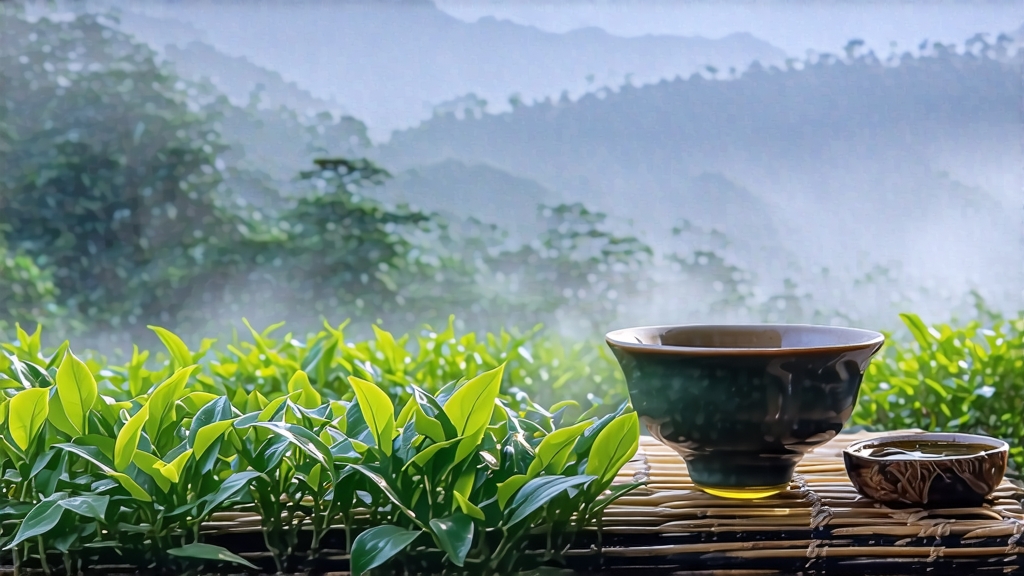
Rising like a jade island from the Tropic of Cancer, Taiwan’s Alishan range catches the first winter monsoon and the last summer typhoon, squeezing them into a perpetual spring above 1,200 m. In that cloud forest, where cypress and camphor perfume the air, grows the cultivar most foreigners simply call “Alishan High-Mountain Oolong.” Yet behind the postcard name lies a 250-year story of Qing settlers, Japanese rail engineers, post-war agronomists, and a new generation of eco-artisans who turned a frontier crop into one of the world’s most coveted amber infusions.
Historical roots
When the Qing court lifted the maritime ban in 1780, Fujian migrants sailed across the strait with cloth bundles of Qing Xin (literally “clear heart”) tea seedlings. They landed in Chiayi County, but the lowland heat produced coarse, bitter leaf. It was not until 1912, under Japanese colonial rule, that the Alishan Forest Railway punched 71 km into the cloud belt. Japanese technicians noticed wild tea shrubs thriving in the red lateritic soil beside cryptomeria groves. They transplanted selected Qing Xin clones to shaded terraces at 1,400 m, recording in their agricultural journals that “the mist slows photosynthesis, concentrating amino acids and floral volatiles.” After retrocession in 1945, the Kuomintang government retained the Japanese test plots, and by 1980 local farmers—many former lumberjacks—were exporting hand-rolled oolong to emerging gourmet markets in Taipei, Tokyo, and Vancouver.
Cultivar & terroir
Alishan High-Mountain Oolong is not a generic brand but a protected geographical indication (PGI) since 2005. To bear the label, the leaf must be Qing Xin (Camellia sinensis var. sinensis), cultivated between 1,000–1,600 m within the townships of Meishan, Zhuqi, Fanlu, and Alishan itself. Diurnal temperature swings of 10–15 °C coax the plant to store sugars and catechins during cool nights, then convert them into monoterpene alcohols (linalool, geraniol) during warm, fog-filtered days. Ultraviolet intensity at altitude boosts flavonoid synthesis, yielding a liquor that is simultaneously creamy and crisp, with a signature note of alpine orchid and white peach.
Plucking standard
The harvest window is brutally short: only the “spring tip” (late March to early May) and the “winter flake” (mid-October to mid-November) qualify. Two leaves and a bud must be snapped before 10 a.m., while dew still pearls the serrated margins. Experienced pickers listen for the audible “snap” of the petiole, a sign that the cell walls are still turgid—essential for the bruising stage that follows.
Crafting the cloud: eight stages in 36 hours
- Solar withering: trays of leaf are laid under high-altitude sun for 20 minutes, just long enough to reduce moisture by 5 % and initiate enzymatic activity.
- Indoor withering: the leaf is then carried into a bamboo-lined room kept at 22 °C and 75 % RH. It is gently tossed every hour for 6–8 hours; the mechanical stress ruptures cell membranes, allowing polyphenol oxidase to meet catechins, seeding the future honeyed aroma.
- Bruising: in a waist-high bamboo drum, the leaf is tumbled for 3 minutes, rested for 15, repeated 5–7 cycles. Masters gauge progress by the red rim that appears on leaf edges—Taiwan’s “green heart with red skirt.”
- Fixation: a 280 °C drum roaster halts oxidation at 25–30 %, preserving the jade center while locking in floral aromatics.
- Ball-rolling: the warm leaf is wrapped in cotton cloth spheres the size of grapefruits. A hydraulic press kneads each orb for 60 seconds, releases, re-wraps, repeats 30 times over 2 hours. This laborious dance twists the leaf into tight hemispheres that will unfurl like miniature ferns during brewing.
- Drying: a 90 °C conveyor oven lowers moisture to 4 %, stabilizing the leaf for months of storage.
- Charcoal finish: traditionalists rest the tea over a low charcoal bed of longan